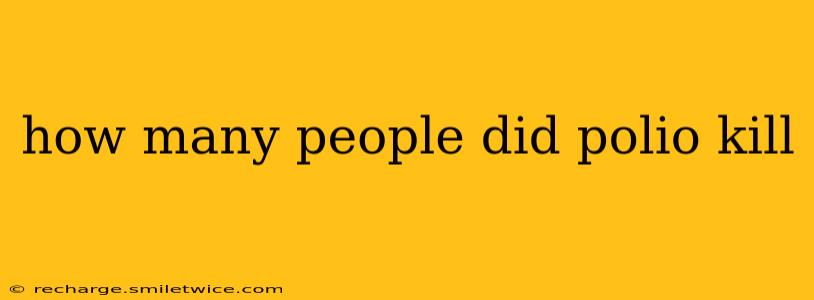Polio, or poliomyelitis, is a debilitating and potentially fatal disease caused by the poliovirus. While largely eradicated thanks to the global polio vaccination campaign, its historical impact was catastrophic, leaving millions dead and countless more with lifelong disabilities. Pinpointing the exact number of deaths caused by polio throughout history is difficult due to inconsistent record-keeping, particularly in less developed nations. However, we can examine the scale of the tragedy and understand the significant reduction in cases achieved through vaccination efforts.
What is the estimated death toll from polio?
While a precise figure is unavailable, estimates suggest that before the widespread availability of the polio vaccine, polio killed hundreds of thousands of people annually and paralyzed many more. In its peak decades, the 1940s and 1950s, polio epidemics crippled and killed tens of thousands in the United States alone. Globally, the impact was far greater, particularly in regions with limited sanitation and healthcare infrastructure. Millions died over the course of the 20th century, and millions more suffered long-term paralysis and other debilitating conditions.
How many people are still paralyzed from polio?
The long-term effects of polio are significant, and many individuals who survived the acute phase of the disease remain paralyzed or experience post-polio syndrome (PPS) decades later. PPS involves a gradual weakening of muscles in those who had recovered from their initial infection. Although accurate global figures are challenging to obtain, the World Health Organization (WHO) continues to monitor the impact of polio and its lingering effects. The ongoing impact on individuals and healthcare systems highlights the importance of complete eradication efforts.
What was the impact of the polio vaccine on mortality rates?
The development and widespread implementation of the polio vaccine represent a monumental achievement in public health. The introduction of the Salk inactivated poliovirus vaccine (IPV) in 1955 and the Sabin oral poliovirus vaccine (OPV) in 1961 drastically reduced polio cases and mortality rates worldwide. The concerted global effort to vaccinate children has led to a dramatic decline in polio cases, pushing the disease to the brink of eradication. While wild poliovirus continues to circulate in some parts of the world, the vaccine's impact on reducing deaths and paralysis is undeniable.
How effective is the polio vaccine?
The polio vaccine is highly effective in preventing polio. IPV offers near-perfect protection against paralytic polio. OPV also provides strong protection, but there is a minute risk of vaccine-derived poliovirus (VDPV) — a rare complication where the weakened virus in the vaccine mutates and causes paralysis. However, the benefits of vaccination far outweigh the risks, and the global vaccination program has made polio a rare disease.
How close are we to eradicating polio?
Thanks to extensive vaccination campaigns, polio is now confined to a small number of countries. The Global Polio Eradication Initiative (GPEI) aims to completely eradicate wild poliovirus. While significant progress has been made, challenges remain, including vaccine hesitancy and conflict in affected regions. Continued efforts are vital to ensuring that polio never again threatens millions of children worldwide.
The true death toll from polio remains unknown, but its impact on human suffering is undeniable. The success of the global vaccination campaign serves as a powerful example of how concerted international collaboration can effectively combat deadly diseases. The fight to eradicate polio continues, and its success would be a testament to the transformative power of preventative medicine.
